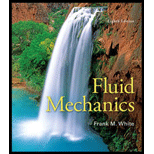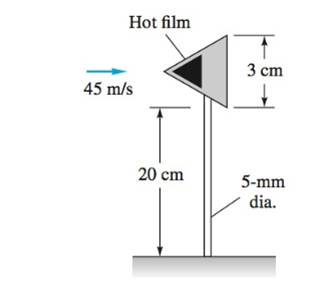
Fluid Mechanics
8th Edition
ISBN: 9780073398273
Author: Frank M. White
Publisher: McGraw-Hill Education
expand_more
expand_more
format_list_bulleted
Textbook Question
Chapter 7, Problem 7.93P
A hot-film probe is mounted on a cone-and-rod system in a sea- level airstream of 45 m/s, as in Fig. P7.93. Estimate the maxim um cone vertex angle allowable if the flow-induced bending moment at the root of the rod is not to exceed 3ON. cm.

P7.93
Expert Solution & Answer
Want to see the full answer?
Check out a sample textbook solution
Students have asked these similar questions
5. Determine the transfer function of G(s) = 01(s)/T₁(s) and 02(s)/T₁ for the mechanical system
shown in Figure Q5. (Hints: assume zero initial condition)
T₁(t) 01(t)
102(1)
Ол
N1
D1
D2
No. 1790220000
N2
Figure Q5
K2
A spring package with two springs and an external force, 200N. The short spring has a loin of 35 mm. Constantly looking for spring for short spring so that total compression is 35 mm (d). Known values: Long spring: Short spring:C=3.98 N/mm Lo=65mmLo=87.4mmF=c·fTotal compression is same for both spring. 200 = (3.98(c1) × 35) + (c₂ × 35)
200 = 139.3 + 35c₂
200 - 139.3 = 35c₂
60.7 = 35c₂
c₂ = 60.7/35
Short spring (c₂) = 1.73 N/mm
According to my study book, the correct answer is 4.82N/mm
What is wrong with the calculating?
What is the reason for this composition?
Chapter 7 Solutions
Fluid Mechanics
Ch. 7 - Prob. 7.1PCh. 7 - A gas at 20°C and 1 atm flows at 6 ft/s past a...Ch. 7 - Prob. 7.3PCh. 7 - Prob. 7.4PCh. 7 - SAE 30 oil at 20°C flows at 1.8 ft3/s from a...Ch. 7 - Prob. 7.6PCh. 7 - P7.7 Air at 20°C and 1 atm enters a 40-cm-square...Ch. 7 - P7.8 Air, p = 1.2 kg/m3 and E-5 kg/(m .s), flows...Ch. 7 - P7.9 Repeat the flat-plate momentum analysis of...Ch. 7 - Repeat Prob. P7.9, using a trigonometric profile...
Ch. 7 - Prob. 7.11PCh. 7 - Prob. 7.12PCh. 7 - Prob. 7.13PCh. 7 - Prob. 7.14PCh. 7 - Prob. 7.15PCh. 7 - A thin flat plate 55 by 110 cm is immersed in a...Ch. 7 - Consider laminar flow past a sharp flat plate of...Ch. 7 - Air at 20°C and 1 atm flows at 5 m/s past a flat...Ch. 7 - Prob. 7.19PCh. 7 - Air at 20°C and I atm flows at 20 m/s past the...Ch. 7 - Prob. 7.21PCh. 7 - Prob. 7.22PCh. 7 - Prob. 7.23PCh. 7 - Prob. 7.24PCh. 7 - Prob. 7.25PCh. 7 - P7.26 Consider laminar boundary layer flow past...Ch. 7 - Prob. 7.27PCh. 7 - Prob. 7.28PCh. 7 - Prob. 7.29PCh. 7 - Prob. 7.30PCh. 7 - Prob. 7.31PCh. 7 - Prob. 7.32PCh. 7 - Prob. 7.33PCh. 7 - Prob. 7.34PCh. 7 - Prob. 7.35PCh. 7 - Prob. 7.36PCh. 7 - Prob. 7.37PCh. 7 - Prob. 7.38PCh. 7 - P7.39 A hydrofoil 50 cm long and 4 m wide moves...Ch. 7 - Prob. 7.40PCh. 7 - Prob. 7.41PCh. 7 - Prob. 7.42PCh. 7 - Prob. 7.43PCh. 7 - Prob. 7.44PCh. 7 - P7.45 A thin sheet of fiberboard weighs 90 N and...Ch. 7 - Prob. 7.46PCh. 7 - Prob. 7.47PCh. 7 - Prob. 7.48PCh. 7 - Based strictly on your understanding of flat-plate...Ch. 7 - Prob. 7.50PCh. 7 - Prob. 7.51PCh. 7 - Prob. 7.52PCh. 7 - Prob. 7.53PCh. 7 - *P7.54 If a missile takes off vertically from sea...Ch. 7 - Prob. 7.55PCh. 7 - Prob. 7.56PCh. 7 - Prob. 7.57PCh. 7 - Prob. 7.58PCh. 7 - Prob. 7.59PCh. 7 - Prob. 7.60PCh. 7 - Prob. 7.61PCh. 7 - A sea-level smokestack is 52 m high and has a...Ch. 7 - For those who think electric cars are sissy, Keio...Ch. 7 - Prob. 7.64PCh. 7 - Prob. 7.65PCh. 7 - Prob. 7.66PCh. 7 - The Toyota Prius has a drag coefficient of 0.25, a...Ch. 7 - Prob. 7.68PCh. 7 - Prob. 7.69PCh. 7 - P7.70 The Army’s new ATPS personnel parachute is...Ch. 7 - Prob. 7.71PCh. 7 - Prob. 7.72PCh. 7 - Prob. 7.73PCh. 7 - Prob. 7.74PCh. 7 - Prob. 7.75PCh. 7 - P7.76 The movie The World’s Fastest Indian tells...Ch. 7 - Prob. 7.77PCh. 7 - Prob. 7.78PCh. 7 - Prob. 7.79PCh. 7 - Prob. 7.80PCh. 7 - Prob. 7.81PCh. 7 - Prob. 7.82PCh. 7 - Prob. 7.83PCh. 7 - P7.84 A Ping-Pong ball weighs 2.6 g and has a...Ch. 7 - Prob. 7.85PCh. 7 - Prob. 7.86PCh. 7 - P7.87 A tractor-trailer truck has a drag area CA =...Ch. 7 - P7.88 A pickup truck has a clean drag area CDA of...Ch. 7 - Prob. 7.89PCh. 7 - Prob. 7.90PCh. 7 - Prob. 7.91PCh. 7 - Prob. 7.92PCh. 7 - A hot-film probe is mounted on a cone-and-rod...Ch. 7 - Baseball drag data from the University of Texas...Ch. 7 - Prob. 7.95PCh. 7 - Prob. 7.96PCh. 7 - Prob. 7.97PCh. 7 - A buoyant ball of specific gravity SG 1 dropped...Ch. 7 - Prob. 7.99PCh. 7 - Prob. 7.100PCh. 7 - Prob. 7.101PCh. 7 - Prob. 7.102PCh. 7 - Prob. 7.103PCh. 7 - Prob. 7.104PCh. 7 - Prob. 7.105PCh. 7 - Prob. 7.106PCh. 7 - Prob. 7.107PCh. 7 - Prob. 7.108PCh. 7 - Prob. 7.109PCh. 7 - Prob. 7.110PCh. 7 - Prob. 7.111PCh. 7 - Prob. 7.112PCh. 7 - Prob. 7.113PCh. 7 - Prob. 7.114PCh. 7 - Prob. 7.115PCh. 7 - Prob. 7.116PCh. 7 - Prob. 7.117PCh. 7 - Suppose that the airplane of Prob. P7.116 is...Ch. 7 - Prob. 7.119PCh. 7 - Prob. 7.120PCh. 7 - Prob. 7.121PCh. 7 - Prob. 7.122PCh. 7 - Prob. 7.123PCh. 7 - Prob. 7.124PCh. 7 - Prob. 7.125PCh. 7 - Prob. 7.126PCh. 7 - Prob. 7.127PCh. 7 - Prob. 7.1WPCh. 7 - Prob. 7.2WPCh. 7 - Prob. 7.3WPCh. 7 - Prob. 7.4WPCh. 7 - Prob. 7.5WPCh. 7 - Prob. 7.6WPCh. 7 - Prob. 7.7WPCh. 7 - Prob. 7.8WPCh. 7 - Prob. 7.9WPCh. 7 - How does the concept of drafting, in automobile...Ch. 7 - Prob. 7.11WPCh. 7 - Prob. 7.12WPCh. 7 - Prob. 7.1FEEPCh. 7 - Prob. 7.2FEEPCh. 7 - Prob. 7.3FEEPCh. 7 - Prob. 7.4FEEPCh. 7 - Prob. 7.5FEEPCh. 7 - Prob. 7.6FEEPCh. 7 - Prob. 7.7FEEPCh. 7 - Prob. 7.8FEEPCh. 7 - Prob. 7.9FEEPCh. 7 - Prob. 7.10FEEPCh. 7 - Prob. 7.1CPCh. 7 - Prob. 7.2CPCh. 7 - Prob. 7.3CPCh. 7 - Prob. 7.4CPCh. 7 - Prob. 7.5CPCh. 7 - It is desired to design a cup anemometer for wind...
Knowledge Booster
Learn more about
Need a deep-dive on the concept behind this application? Look no further. Learn more about this topic, mechanical-engineering and related others by exploring similar questions and additional content below.Similar questions
- Homework: ANOVA Table for followed design B AB Dr -1 -1 1 (15.18,12) 1 -1 -1 (45.48.51) -1 1 -1 (25,28,19) 1 1 (75.75,81)arrow_forward20. [Ans. 9; 71.8 mm] A semi-elliptical laminated spring is made of 50 mm wide and 3 mm thick plates. The length between the supports is 650 mm and the width of the band is 60 mm. The spring has two full length leaves and five graduated leaves. If the spring carries a central load of 1600 N, find: 1. Maximum stress in full length and graduated leaves for an initial condition of no stress in the leaves. 2. The maximum stress if the initial stress is provided to cause equal stress when loaded. [Ans. 590 MPa ; 390 MPa ; 450 MPa ; 54 mm] 3. The deflection in parts (1) and (2).arrow_forwardQ6/ A helical square section spring is set inside another, the outer spring having a free length of 35 mm greater than the inner spring. The dimensions of each spring are as follows: Mean diameter (mm) Side of square section (mm) Active turns Outer Inner Spring Spring 120 70 8 7 20 15 Determine the (1) Maximum deflection of the two springs and (2) Equivalent spring rate of the two springs after sufficient load has been applied to deflect the outer spring 60 mm. Use G = 83 GN/m².arrow_forward
- Q2/ The bumper springs of a railway carriage are to be made of rectangular section wire. The ratio of the longer side of the wire to its shorter side is 1.5, and the ratio of mean diameter of spring to the longer side of wire is nearly equal to 6. Three such springs are required to bring to rest a carriage weighing 25 kN moving with a velocity of 75 m/min with a maximum deflection of 200 mm. Determine the sides of the rectangular section of the wire and the mean diameter of coils when the shorter side is parallel to the axis of the spring. The allowable shear stress is not to exceed 300 MPa and G = 84 kN/mm². Q6/ A belicalarrow_forward11. A load of 2 kN is dropped axially on a close coiled helical spring, from a height of 250 mm. The spring has 20 effective turns, and it is made of 25 mm diameter wire. The spring index is 8. Find the maximum shear stress induced in the spring and the amount of compression produced. The modulus of rigidity for the material of the spring wire is 84 kN/mm². [Ans. 287 MPa; 290 mm]arrow_forwardWhat is the reason for this composition?arrow_forward
- Homework: ANOVA Table for followed design B AB Dr -1 -1 1 (15.18,12) 1 -1 -1 (45.48.51) -1 1 -1 (25,28,19) 1 1 (75.75,81)arrow_forwardS B Pin 6 mm Garrow_forwardMid-Term Exam 2024/2025 Post graduate/Applied Mechanics- Metallurgy Q1/ State the type of fault in the following case, and state the structure in which it will appear. АВСАВСВАСВАСАВСАВСarrow_forward
- الثانية Babakt Momentum equation for Boundary Layer S SS -Txfriction dray Momentum equation for Boundary Layer What laws are important for resolving issues 2 How to draw. 3 What's Point about this.arrow_forwardR αι g The system given on the left, consists of three pulleys and the depicted vertical ropes. Given: ri J₁, m1 R = 2r; απ r2, J2, m₂ m1; m2; M3 J1 J2 J3 J3, m3 a) Determine the radii 2 and 3.arrow_forwardB: Solid rotating shaft used in the boat with high speed shown in Figure. The amount of power transmitted at the greatest torque is 224 kW with 130 r.p.m. Used DE-Goodman theory to determine the shaft diameter. Take the shaft material is annealed AISI 1030, the endurance limit of 18.86 kpsi and a factor of safety 1. Which criterion is more conservative? Note: all dimensions in mm. 1 AA Motor 300 Thrust Bearing Sprocket 100 9750 เอarrow_forward
arrow_back_ios
SEE MORE QUESTIONS
arrow_forward_ios
Recommended textbooks for you
 Principles of Heat Transfer (Activate Learning wi...Mechanical EngineeringISBN:9781305387102Author:Kreith, Frank; Manglik, Raj M.Publisher:Cengage Learning
Principles of Heat Transfer (Activate Learning wi...Mechanical EngineeringISBN:9781305387102Author:Kreith, Frank; Manglik, Raj M.Publisher:Cengage Learning

Principles of Heat Transfer (Activate Learning wi...
Mechanical Engineering
ISBN:9781305387102
Author:Kreith, Frank; Manglik, Raj M.
Publisher:Cengage Learning
Heat Transfer – Conduction, Convection and Radiation; Author: NG Science;https://www.youtube.com/watch?v=Me60Ti0E_rY;License: Standard youtube license